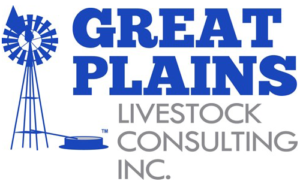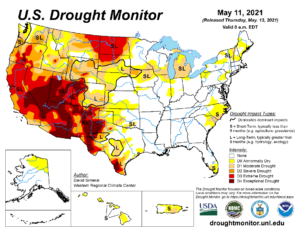Developing Your Drought Plan
It seems as though every year someone, somewhere is experiencing drought and this year appears to be no exception. The UNL drought monitor indicates that most of northern IA, Hi-Plains, and the West are experiencing some level of drought that does not seem to be letting up.
When faced with drought conditions, it is important to develop a plan to deal with the impact on feed resources that will be available for your operation, whether that be a finishing yard, backgrounding yard, or cow/calf operation. Whichever the case, we need to be making the right decisions now in terms of taking care of light calves and making sure we keep cows in good enough condition to breed back and have another calf next year.
Grazing Plan
During times of drought, it is essential to have a grazing plan in place to ensure you do not overgraze and impact the future growth of rangeland when the drought passes. Some possible grazing strategies to consider are:
- Delay turn-out by feeding hay an additional couple of weeks, if there is still an adequate supply of last year’s hay inventory.
- Put up electric fencing within pastures to concentrate the grazing areas and frequently rotate the cattle.
Adjusting Inventory and Culling Cows
One of the most obvious choices when facing limited forage for the grazing season is to cull cows that need to be culled. Now would be the time to get rid of any wild cows, cows with bad udders, and cows that are starting to become not as profitable for your operation. Culling these cows sooner rather than later can pay off because it keeps you from selling when the market is flooded with cull cows and the price drops. If you typically background your calves on grass, it might be a good idea to look at taking those cattle to a dry lot earlier to help stretch your pastures for the cows.
Feeding Cows in Confinement
If pasture availability becomes very limited, some producers may need to consider feeding their cows in confinement. If this is the case, you need to make sure you have adequate pen and bunk space for those cows. The general recommendation for pen space is approximately 500 to 800 square feet per cow-calf pair. You should have roughly 28-36 inches of bunk space per cow, depending on her weight.
Cow rations tend to be bulkier due to the higher forage levels, therefore, having deep feed bunks will help control the amount of feed waste. Cheaper forages such as corn stalks, CRP hay, or straw can be used in cow rations to help reserve higher quality hays for backgrounding and finishing cattle. Rations can either be full-fed or limit-fed depending on your facility’s capabilities. Limit feeding cows will typically save you quite a bit of money compared to full feeding. A cost comparison of 3 different cow management systems is presented in Table 1. The input cost estimates used for this comparison are in Table 2. Based on current feed prices, it appears a semi-confinement system may be the most cost-effective way to manage the cow herd. If this is an option you would like to explore more, one of the consultants at Great Plains Livestock Consulting, Inc. would be happy to assist you https://www.gplc-inc.com/ourteam/!
Table 1. Cow Management System Cost Comparison, $/head/day
Traditional
$2.09
5 months on pasture, 4 months on pasture, and the remaining 3 months fed a lactation ration.
Total Confinement
$2.32
Fed in confinement year-round.
Semi-Confinement
$1.56
Graze stalks 5 months then fed in confinement the remainder of the year.
Table 2. Estimated Input Cost, $/head/day
Pasture Rent
$2.67
Corn Stalk Grazing Rent
$0.75
Yardage/Labor
$0.50
Grazing Mineral
$0.10
Gestation Ration Cost
$1.61
Lactation Ration Cost
$2.05
Grazing Labor
$0.10
Early Weaning Calves
During times of drought, early weaning calves can very well be essential. Weaning calves early reduces the nutrient requirements of the cows by 25-40% and reduces forage use by 20-35%, depending on the stage of lactation the cows are in when the calves are weaned. If you are going to early wean your calves, you should make sure you have a vaccination plan and feeding strategy in place. One of the biggest considerations for an early weaning program for calves will be the diet. Feeds that are low in protein and available energy (and sometimes cheaper) will not do a good job at starting early weaned calves and keeping them going. These diets need to be higher in protein (16-18% crude protein, DM basis) and moderate in safe, useable energy levels. If you would like to look at this option, a consultant at Great Plains Livestock Consulting, Inc. would be happy to assist you https://www.gplc-inc.com/ourteam/.
Creep Feeding
Creep feeding calves does not impact a cow’s milk production or forage consumption, therefore creep feeding will not have near the impact early weaning will. Usually, when feed is cheap, it pays very well to creep feed calves. In times when feed prices increase, more consideration should be taken. If pasture supply is short, but there is nowhere else to go with the cattle, then creep feeding can help. One of the best reasons for creep feeding in times like this might be the way it lets a producer train the light calf to come to the bunk to eat and thus set them up for an easier transition if the need arises to early wean those calves.
Feedlots
During times of drought harvested forages become a valuable commodity that can be hard to come by. Now is the time to start talking to growers in your area to secure your silage needs. As silage is placed into the pit, a sample should be taken for analysis to ensure that the purchase price is fair for both you and the grower.
Additionally, now would be a good time to lock in your summer contracts for byproducts, as they will be in higher demand for feeding cows or early weaned calves. It would also be good to put a plan together for managing the early-weaned calves that might be coming into the yard.
Conclusion
Hopefully, these plans will not be needed and rain will come, but if not, have your trigger dates set so that you can start destocking when needed. Remember, rank livestock by cull-ability. Getting rid of cull cows early, get yearlings off grass first, and early wean calves all before making cuts to the nebulous of the cow herd. If you feed cattle in the lot, stockpile harvested forages early and lock in summer contracts for byproducts as soon as possible.

Article provided by Great Plains Livestock Consulting Inc.

